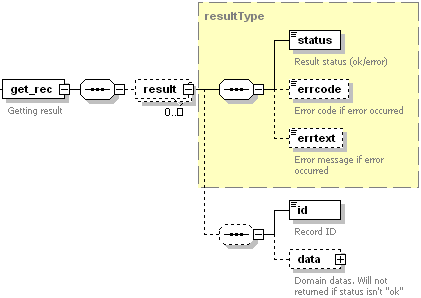Retrieving DNS Records
Both zone template records and site or site alias zone records can be retrieved using the get_rec operation. You can retrieve multiple records in a single get_rec operation using filtering rules. For more information about filters, refer to the Available Filters section.
Request Packet Structure
A request XML packet retrieving a DNS record from Plesk database includes the get_rec operation node:
<packet>
<dns>
<get_rec>
...
</get_rec>
</dns>
</packet>
The graphical representation of the get_rec node is as follows:

Note: The interactive schema navigator for all request packets is available here: http://plesk.github.io/api-schemas/1.6.9.1/agent_input.svg.
- The filter node is required. It specifies the filtering rule.
For more information, refer to the Available Filters
section. Data type:
dnsSelectionFilterType (
dns_input.xsd) . - The template node is optional. If present, only DNS zone template records are available for retrieving. In this case filter children cannot be specified as a filtering rule. Data type: none.
Note: If you leave the filter node blank (<filter/>), all resource
records (zone template records or zone records depending on presence
of the template node in the request packet) will be retrieved.
You can retrieve multiple DNS records in a single packet. Add as many get_rec operations as the number of different filtering rules.
<dns>
<get_rec>
...
</get_rec>
...
<get_rec>
...
</get_rec>
</dns>
Note: When creating request packets, put nodes and elements in the order they follow in the packet structure.
Response Packet Structure
The get_rec node of the output XML packet is structured as follows:

Note: The interactive schema navigator for all response packets is available here: http://plesk.github.io/api-schemas/1.6.9.1/agent_output.svg.
-
The result node is optional. It is required if the operation get_rec succeeds, and the data set retrieved from the server is not empty. Data type: resultType (
common.xsd). -
The status node is required. It specifies the execution status of the get_rec operation. Data type: string. Allowed values: ok | error.
-
The errcode node is optional. It is used to return the error code when the get_rec operation fails. Data type: unsignedInt.
-
The errtext node is optional. It is used to return the error message if the get_rec operation fails. Data type: string.
-
The id node is required if the get_rec operation has succeeded. Returns the unique identifier of the DNS record. Data type: integer.
-
The data node is optional. It is required if the get_rec operation has succeeded. Data type: dnsRecord (
dns_input.xsd). The node is structured as follows:- The site-id node is optional. If specified, the DNS record is retrieved from zone parameters for the site with the corresponding ID. Data type: integer.
- The site-alias-id node is optional. If specified, the DNS record is retrieved from zone parameters for the site alias with the corresponding ID. Data type: integer.
- The type node is optional. It is required if the operation succeeded. It specifies the type of the DNS record. For more information about DNS types, please visit the Adding a DNS Record section. Data type: string. Allowed values: A | NS | CNAME | MX | PTR | TXT | SOA | AXFR | SRV | AAAA | DS.
- The host node is optional. It is required if the operation succeeded. It specifies the IP address or name of a host, that will be used by DNS. Data type: string.
- The value node is optional. It is required if the operation succeeded. It specifies the value that will be linked with the host value. Data type: string.
- The opt node is optional. It holds optional information about the DNS record. Data type: string.
Retrieving a single DNS record
This request packet retrieves the DNS record with ID 8.
<packet>
<dns>
<get_rec>
<filter>
<id>8</id>
</filter>
</get_rec>
</dns>
</packet>
Response:
<packet>
<dns>
<get_rec>
<result>
<status>ok</status>
<id>8</id>
<data>
<site-id>8</site-id>
<type>NS</type>
<host>Mysite.com</host>
<value>ns.Mysite.com</value>
<opt/>
</data>
</result>
</get_rec>
</dns>
</packet>
If the DNS record with ID 8 was not found on the server, the response looks as follows:
<packet>
<dns>
<get_rec>
</get_rec>
</dns>
</packet>
Retrieving multiple DNS records
This request packet retrieves zone preferences of the site with ID 8.
<packet>
<dns>
<get_rec>
<filter>
<site-id>8</site-id>
</filter>
</get_rec>
</dns>
</packet>
Response:
<packet>
<dns>
<get_rec>
<result>
<status>ok</status>
<id>18</id>
<data>
<site-id>8</site-id>
<type>NS</type>
<host>Mysite.com</host>
<value>ns.Mysite.com</value>
<opt/>
</data>
</result>
</get_rec>
<get_rec>
<result>
<status>ok</status>
<id>19</id>
<data>
<site-id>8</site-id>
<type>PTR</type>
<host/>
<value>Mysite.com</value>
<opt/>
</data>
</result>
</get_rec>
</dns>
</packet>
If the site with ID 8 was not found on the server, the response from the server looks as follows:
<packet>
<dns>
<get_rec>
</get_rec>
</dns>
</packet>
